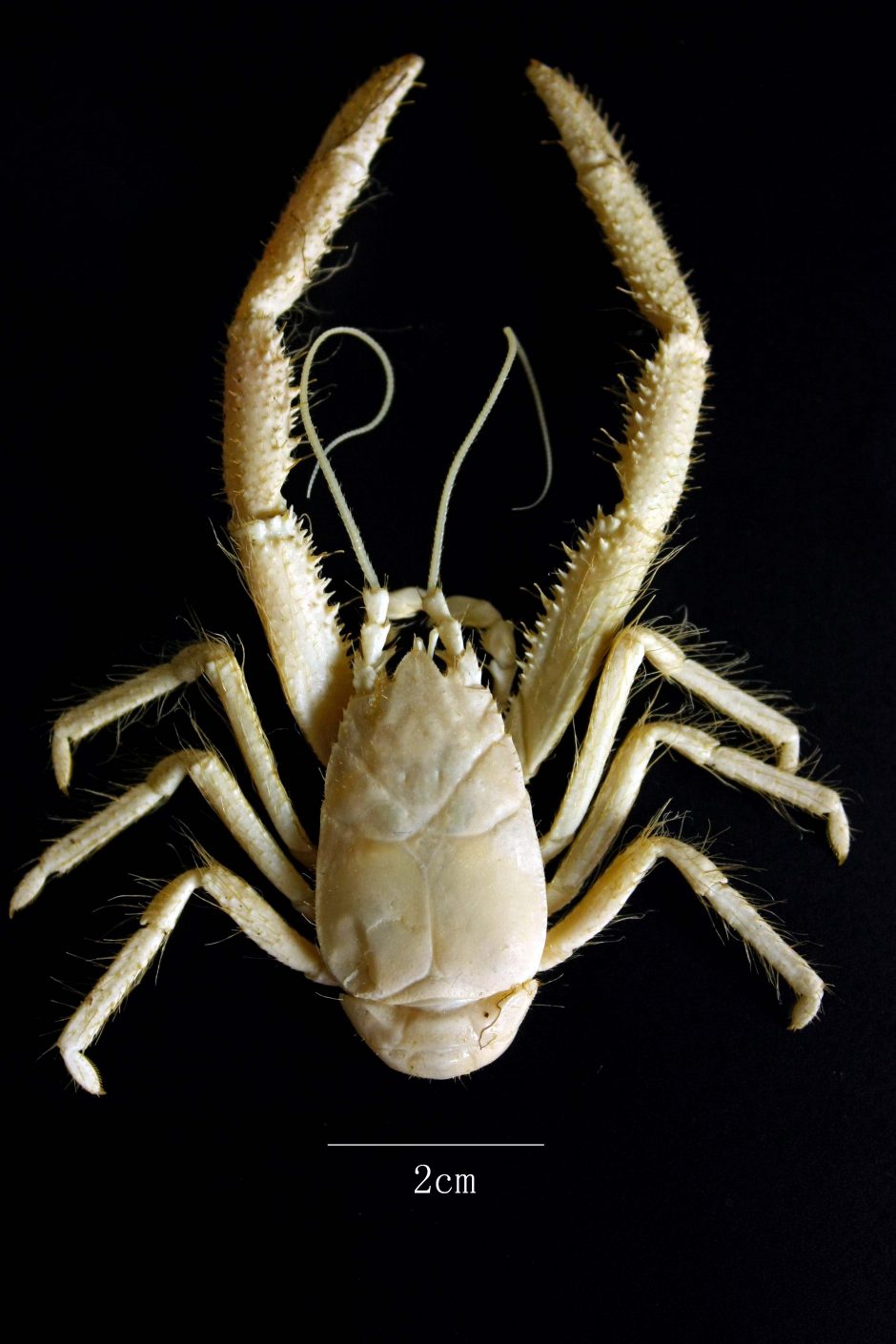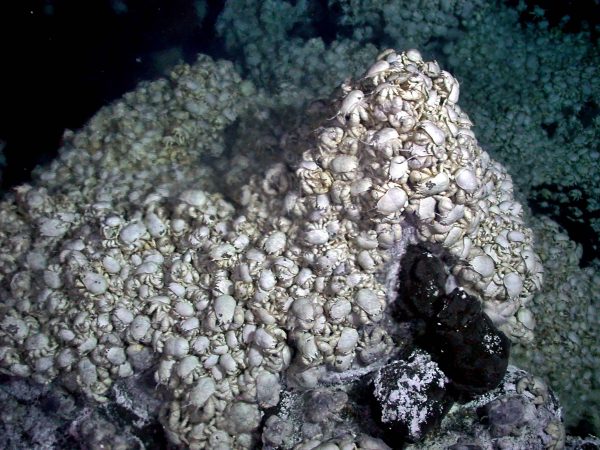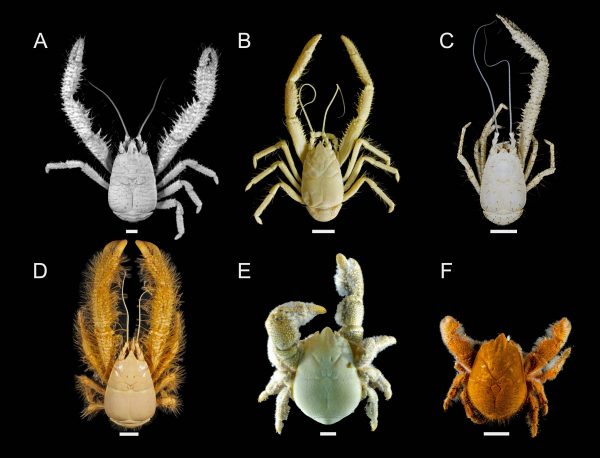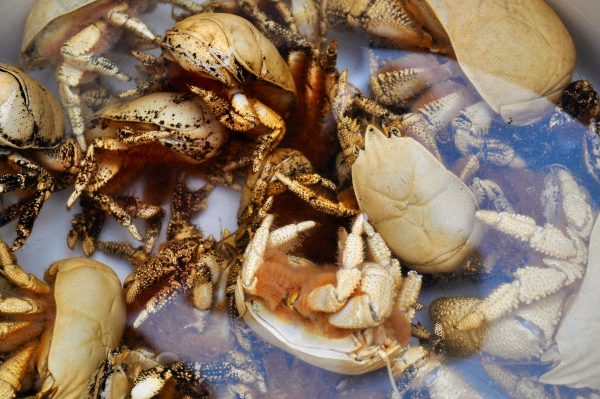Genetic Study of Yeti Crabs Reveals Likely Common Ancestor—and Vulnerability

Kiwa sp from Galapagos microplate. (Credit: Dr. Roterman)
A strange and sad fact of life in the anthropocene is the ability to discover new species and the simultaneous inevitability that many of these newly discovered species will be threatened. Forces now inherent to this age, such as climate change, habitat destruction, and resource exploitation, are proving to be formidable—and in some cases insurmountable—foes for many a rare species.
Since 2005, we have known about the Kiwaidae or yeti crabs. These odd denizens of deep-sea hydrothermal vents have pale bodies and hairy claws that conjure up images of the mythical yeti, but their plight thanks to various environmental threats is very real.
A vulnerable existence
New research on Kiwaidae from Oxford University presents a comprehensive genetic analysis of all species of these yeti crabs, and indicates that they may be at serious risk. Christopher Nicolai Roterman, an Oxford University postdoctoral researcher in the Department of Zoology and the study’s co-lead author, corresponded with EM about the research.
“The evolutionary history of the Yeti crabs have interested me since I was a part of a UK-led expedition in 2010 that discovered a new species in the Southern Ocean, nicknamed the ‘Hoff crab,’ which was formerly described as Kiwa tyleri,” explains Dr. Roterman. “A year later another UK expedition in the southwestern Indian Ocean discovered a similar species. This prompted me to see if I could unravel the evolutionary history of the whole family—which at the time only included four putative species—with the use of phylogenetics, which is the inference of relatedness by the comparison of genes between the different species.”
The research indicates that the species diversity and geographic range of the family may have been significantly influenced by past environmental changes—and this in turn suggests that the animals may again be very vulnerable to such outside change. This is the kind of change wrought by a warming climate, and by habitat destruction and resource exploitation by humans.
Several lines of circumstantial evidence may hint at an increased vulnerability within the yeti crab family compared to other hydrothermal vent groups.
“Firstly, there are very few species of Yeti crab that we know of today, hinting that since their origin many lineages may have gone extinct,” details Roterman. “Secondly, their mode of larval dispersal indicates a more limited dispersal capacity compared to other vent species; if local or regional conditions become unsuitable, their larvae may be less likely to find new locations to colonize, leaving them more vulnerable to regional extinction. Finally, along with other crab and lobster-like vent crustaceans (decapods), their gills are housed under their carapace, constraining the maximum possible surface area for oxygen absorption, hinting that animals such as these would be less likely to weather more hypoxic conditions in the ocean.”
Notably, Dr. Roterman points out that decapod crustaceans at vents as a whole appear to be more recent vent colonizers compared to other groups, perhaps suggesting that animals like these experience extinction more often at vents. This flies in the face of conventional wisdom, which surveys the impressive adaptations of vent animals to their conditions and concludes that all of these animals must be hardy survivors.

Kiwa tyleri in water. (Credit: Dr. Roterman)
“[We previously thought these animals were] living fossils persisting through countless environmental changes that had resulted in extinction events on land and in the oceans in general,” remarks Roterman. “The research of recent years, including my own, may now suggest the opposite: that vent animals may regularly go extinct over a timescale of tens of millions of years, with subsequent colonizers evolving adaptations and diversifying before they too go extinct.”
Most yeti crabs inhabit extreme habitats; this might point to an ability to adapt, but it also signifies a limited range—another point of vulnerability.
“Most deep-sea animals survive on the small quantities of organic matter that sinks down from the surface, but hydrothermal vents sustain an enormous biomass of microbes that can get energy from the chemicals in the fluid, providing a potential food bonanza for animals,” remarks Roterman. “The tradeoff is that hydrothermal vents expose animals to high temperatures, high acidity and low oxygen, so these animals slowly evolve adaptations that allow them to increasingly exploit the food resource. The consequence of all these adaptations, however, is that these animals cannot survive away from a vent and this specialization is a weakness, evolutionarily speaking. Vent animals can only survive if there is enough suitable habitat for them. Global warming and deep-sea mining may reduce the amount of suitable habitat for these animals in the future.”
But which factors, specifically, have made the yeti crab been so much more vulnerable to the effects of human resource exploitation and climate change than initially thought? In other words, is it an especially delicate species, or is the takeaway that many different species may well be more vulnerable than we imagine?
“The truth is, we don’t know for sure if yeti crabs are more vulnerable to extinction than other hydrothermal vent animals,” states Roterman. “There is evidence that hydrothermal vent animals in general may be more vulnerable to long term changes in deep-sea oxygen availability, which is influenced by climate and geology, than non-vent deep-sea animals, because these animals already exist at the physiological extremes of low oxygen (hypoxia) tolerance.”
Common ancestry
The research also reveals that the yeti crabs alive today are probably descended from a common ancestor. This pioneer lived in the southeast Pacific about 30 to 40 million years ago, and inhabited deep sea hydrothermal vents along mid-ocean ridges.
“Phylogenetic studies like mine have tended to show that most types of deep-sea vent animals today are each descended from common ancestors living no earlier than 50 million years ago,” explains Dr. Roterman. “We know that a super warm period 50 to 55 million years ago—the Paleocene-Eocene Thermal Maximum (PETM)—reduced deep-sea oxygen levels substantially, and it seems likely that the previous diversity of vent life went extinct during this warm phase. The current diversity of vent life is descended from animals that recolonized vents as conditions improved after the PETM.”
Using phylogenetic methods, the team has made a compelling circumstantial case for the proposition that hydrothermal vent species have gone extinct across extensive regions. In other words, their limited modern locations do not necessarily reflect their historical distribution. The team determined this in part by comparing the location of current yeti crab species with their history of diversification.

All known species of yeti crabs. (Credit: Dr. Roterman)
“Species ranges for vent animals will often span many hydrothermal vent patches or fields across 100s or even 1000s of kilometers of mid-ocean ridge,” details Roterman. “While adult animals are stuck on individual vents, their larvae are released into the currents and some lucky individuals will happen upon another vent and colonize it. This is an essential component of how a species persists over a range, because individual vent fields don’t last forever and eventually cease to be active. Thus the range extent of a species represents a dynamic process over time of animals colonizing new vents through larval dispersal (broadcasting, like windborne seed dispersal), while older vents cease to become geothermal active resulting in the death of individuals on that particular vent chimney or cluster of vent chimneys (a vent field).”
Thus, Roterman explains, over millions of years the history of diversification of a particular group of related vent animals often reflects geological changes that have happened at mid-ocean ridges. By comparing current species locations with a phylogenetic tree, it’s possible to see where a particular group originated and how it spread and diversified over time.
“This is somewhat analogous to the way that we can look at where different Galapagos finches are today on the Galapagos Islands and look at a phylogenetic tree showing how the different species are related together and then infer how and when the different islands were colonized,” adds Roterman.
The researchers found that the crabs probably existed in large regions of mid-ocean ridge in the Eastern Pacific, but they are now extinct in those areas.
“While there are regions mid-ocean ridge where we have yet to explore that may house yeti crabs, there are also large areas in the East Pacific where we can confirm their absence that surround isolated pockets hosting yeti crabs,” Roterman describes. “Based on what we know about how they disperse, yeti crabs could only have gotten there if they had once inhabited the intervening stretches of mid-ocean ridge. This is how we have inferred their extinction in those regions.”
They also determined that a shift in deep sea oxygen levels caused by climate change and changes to hydrothermal activity at mid-ocean ridges were the ultimate sources of the problem, and that these shifts may have been linked to discrete events in the past. To survive, a species must be able to effectively disperse itself, and its habitat must have sufficient longevity in enough locations for the dispersal technique to work. Dr. Roterman sees significance in the extinctions in the tropical East Pacific, a notably precarious environment for the yeti crabs.
“Firstly, vent fields on this stretch of mid-ocean ridge are believed to be more short-lived than in other regions, with volcanic eruptions common that can resurface large areas of mid-ocean ridge, wiping out vent communities,” remarks Roterman. “Secondly, the deep-sea in this region has lower oxygen levels than in other places in the world and thirdly, the deep-sea is warmer than other regions where yeti crabs are more dominant. Yeti crabs may be more vulnerable to reduced oxygen availability for physiological reasons, and this along with warmer ambient deep-sea water may limit how far their larvae can disperse.”
This combination of factors, should it intensify or worsen, would make survival, already challenging for the yeti crabs, impossible.
“As a result, one or a combination of these factors, such as a particularly large eruptive event, a slight drop in regional hydrothermal activity, or a change in water temperature or oxygen availability, may have wiped out yeti crabs in some regions but not others, while other groups of animals were either able to persist or recolonize after the disturbance. Looking back across the last 30-40 million years, the genetic analysis indicates that cooler, more oxygenated conditions in the Pacific coincide with key moments in the diversification of the yeti crabs, suggesting that the more ‘random’ or stochastic geological changes that affect the viability of yeti crabs in a particular region occur against a backdrop of favorable or unfavorable oceanographic conditions over time.”

Close up of Kiwa tyleri. (Credit: Dr. Roterman)
Determining just how vulnerable these populations might be is a real challenge for scientists. Roterman and the team of researchers in this case went to great lengths simply to collect specimens for genetic analysis.
“All of the yeti crabs were sampled from depths of roughly 1000 to 3000 meters, and with the exception of one species they are all found at hydrothermal vents in international waters that require large 80 to 120 meter ocean-going research vessels to embark on four to six week expeditions,” details Roterman. “For example the Hoff crab, Kiwa tyleri was sampled by the UK-funded Royal Research Ship James Cook in 2010 during a six-week expedition to the Scotia Sea, about 500 kilometers southeast of South Georgia.”
Deep sea treasures
Finding and collecting samples of species like yeti crabs is in some ways analogous to treasure hunting. It’s not always easy to find what you’re searching for, and when you do, you can’t retrieve it without deploying the right kinds of equipment.
“Two species were collected with the US human-operated vehicle (HOV) Alvin in the Pacific from the research vessel Atlantis, two species were collected with the UK-funded remotely operated vehicle (ROV) Isis and another two species were collected by trawling and a type of grabbing device deployed from the ship,” Roterman describes. “HOV Alvin is one of a handful of submersibles worldwide that can dive to depths of 6,000 meters with three people inside. ROV Isis, which is tethered to the parent ship (RRS James Cook) can dive to depths of 6,500 meters and is piloted remotely from a control room with the aid of HD cameras and high resolution sonar. Both the HOV Alvin and ROV Isis have titanium manipulators with which to collect samples. All of these specimens are incredibly precious given the cost of sampling them. Kiwa hirsuta, the first known yeti crab, discovered in 2005 with HOV Alvin, is represented by only one specimen.”
Despite these extreme technical challenges, Dr. Roterman is careful to point out that we still really know relatively little about deep sea environments, which suggests we should be very careful when disturbing them.
“There is no simple way to assess the reliance of a deep-sea species to environmental disturbance,” cautions Dr. Roterman. “On the surface we can more easily estimate how large populations are and also monitor how inbred these populations are by regularly examining the genetic diversity within and between these populations. We can study the ecological characteristics and biology of the species to develop a fairly well-informed picture of how well these animals may respond to climate change or habitat loss. With deep-sea animals, the priority at the moment is to visually survey more seafloor. To better assess the size and reliance of populations, we need to sample individuals to assess the levels of genetic diversity within and between populations. That takes time and effort. In the meantime, the precautionary approach should be the default setting when it comes to exploiting resources in the deep sea, whether it’s deep-sea trawling or mining.”
Another parallel with treasure hunting is the importance of protecting our shared undersea legacy—something that goes unappreciated too often.
“Just because deep-sea animals are out of sight, it doesn’t follow that they’re immune to environmental change—which includes human-induced environmental change. Who knows what might go extinct before we even know what’s there? I suppose there’s a moral dimension to argument of responsible stewardship of the oceans—but also a pragmatic one—as deep-sea diversity may be a biomedical treasure trove.”
Still, for Dr. Roterman and other fans of the natural world, there is no greater reward to be had than finding and studying creatures like the yeti crabs.
“As a deep-sea evolutionary biologist, nothing ceases to amaze me with the ways that animals have adapted to life in the deep sea,” adds Dr. Roterman. “The yeti crabs are especially interesting because they do not appear to use their claws as crushing tools, but instead are covered in fine setae or ‘hairs’, which they use as a surface to cultivate the bacteria that get their energy from the hydrothermal fluid. They have specialized comb-like feeding appendages that they use to strain through the hairs to feed on the bacteria. They basically farm bacteria on their beards. The yeti crab closest to my heart is the ‘Hoff crab’—so named because the hairs are concentrated on the ‘chest’ or ventral surface—giving it a hairy-chested appearance, not unlike the Baywatch actor after whom it is nicknamed. These animals can be found so close to the hydrothermal fluid that they can actually be cooked alive, as I myself have witnessed.”




0 comments